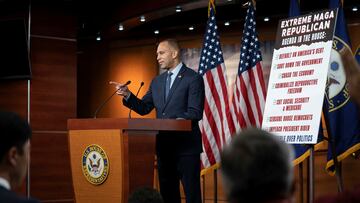How many Democrats voted to pass the bill to avoid a government shutdown?
The US government looks like it will avoid a government shutdown due to another short-term bill being passed to keep funding going.


The House of Representatives voted to pass Speaker Mike Johnson’s plan to continue funding the government with stopgap measures until after Christmas.
With the deadline looming this coming weekend, Johnson’s plan was two respective funding plans. In an unusual move, different parts of federal spending has been divided with two seperate deadlines. The first deadline, 19 January, would include funding for transportation and housing amongst other things, while the second deadline would expire on 2 February. This would include funding the military.
The lack of funding cuts in the bill alarmed right-wing Republicans, who refused to back the bill, meaning Democrats needed to support the bill for it to pass.
209 Democrats and only 127 Republicans vote to fund the government and prevent a shutdown pic.twitter.com/GPIZoYEg8z
— Acyn (@Acyn) November 14, 2023
“I understand it’s likely to clear the House on a bipartisan basis. It’s nice to see us working together to prevent a government shutdown,” said Senate Minority Leader Mitch McConnell. “And we’ll deal with all of the other big issues that we have ahead of us during this period between now and the time the CR expires.
The bill will now go to the Senate where it is expected to be passed before heading to the president’s desk later in the week.
Why did Democrats support Mike Johnson’s plan?
The plan needed two-thirds support to pass, meaning the bill needed 290 votes to pass. The tiny Republican majority currently present was never going to be enough to pass Johnson’s bill, so Democrat votes were a necessity.
Particular aspects Democrats would never have voted for, such as spending cuts, were left out. Thus, the bill continued current spending levels, something Democrats have no problem voting for.
House Democratic Leadership Statement on the importance of preventing a Government Shutdown. pic.twitter.com/ndEsy0rNZ1
— Hakeem Jeffries (@RepJeffries) November 14, 2023
In the end, 336 representatives voted in favour of the resolution, while 95 voted against. 209 out of 211 Democrats voted for the measure, more than the number of Republicans.
Related stories
“House Democrats have repeatedly articulated that any continuing resolution must be set at the fiscal year 2023 spending level, be devoid of harmful cuts and free of extreme right-wing policy riders,” a House Democrat Leadership statement said. “The continuing resolution before the House today meets that criteria and we will support it.”
A government shutdown has the potential to be very bad for the US economy, not to mention federal workers who would have pay delayed should the business of government grind to a halt.

